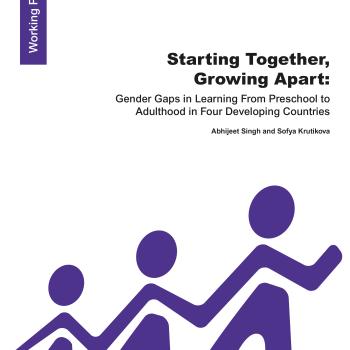
This working paper studies the evolution of gender gaps in multiple cognitive skills from the ages of 5 to 19 years old, using Young Lives unique panel data from Ethiopia, India, Peru and Vietnam; it is the most extensive panel-based investigation on this question in developing countries.
The findings suggest that, in all four countries, gender gaps in learning are either absent or small in absolute magnitude prior to school entry (at 5 years old) and at primary school age (8 years old). Larger gaps emerge later, widening particularly between the ages of 12 and 15; gaps favour boys in Ethiopia, India and Peru, but girls in Vietnam. This is in contrast to OECD contexts, where significant gender gaps in maths and language skills tend to be in the same direction. Subsequently, these learning gaps appear to mostly persist until early adulthood. In establishing the direction, magnitude, and persistence of gender gaps, we pay careful attention to issues of ordinality and decay in test scores. Panel-based, value-added models with a rich set of covariates including past achievement, child health, time use, parental education and wealth, and school quality explain at most half to two-thirds of the cross-sectional gender gap in test scores at 15 years old.

This working paper studies the evolution of gender gaps in multiple cognitive skills from the ages of 5 to 19 years old, using Young Lives unique panel data from Ethiopia, India, Peru and Vietnam; it is the most extensive panel-based investigation on this question in developing countries.
The findings suggest that, in all four countries, gender gaps in learning are either absent or small in absolute magnitude prior to school entry (at 5 years old) and at primary school age (8 years old). Larger gaps emerge later, widening particularly between the ages of 12 and 15; gaps favour boys in Ethiopia, India and Peru, but girls in Vietnam. This is in contrast to OECD contexts, where significant gender gaps in maths and language skills tend to be in the same direction. Subsequently, these learning gaps appear to mostly persist until early adulthood. In establishing the direction, magnitude, and persistence of gender gaps, we pay careful attention to issues of ordinality and decay in test scores. Panel-based, value-added models with a rich set of covariates including past achievement, child health, time use, parental education and wealth, and school quality explain at most half to two-thirds of the cross-sectional gender gap in test scores at 15 years old.

